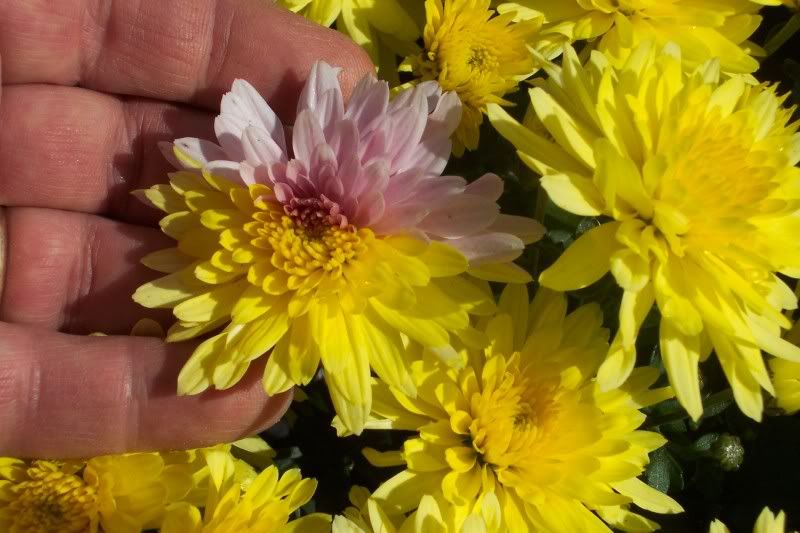Have you ever seen a flower with two colors on one blossom? Yes, of course you have.
Have you ever seen a flower with two colors on one blossom where the colors are divided exactly down the middle? Now that’s a little more rare.

How this occurs is an interesting process.
Let’s briefly review how a flower is formed. Think back to your high school biology. Plants are made up of small, microscopic structures called cells. The cells grow and divide over and over again until you have a fully formed plant.
Inside of the growing tip of a bud (called a meristem) there are many many cells dividing like crazy in order to get a flower to form and blossom in one growing season. Each time they divide, they pass on a blueprint of how the flower is to be built. This is called genetics.
All of those millions of cells start out as just one cell. That one cell divides into two cells. At this very early stage, something happened to one of those two cells. The genetic blueprint didn’t get copied exactly right, the blueprint says it is supposed to be a Mum blossom but instead of painting it yellow, it specifies pink as the color.
All of the descendants from that one pink cell “thinks” the flower should be pink, while all the descendants from the yellow cell know it is supposed to be yellow because it is a yellow Mum.
Those darn pink cells are stubborn and continue with their pink idea until the flower is completely built. And guess what? Exactly half of the flower is pink and the other half is the color it is supposed to be…yellow.
In the horticulture trade this is called a chimera. This is one way how different varieties are begun.
An observant grower will notice something unusual happening with a single plant, often just a single stem on a plant. If it looks promising, he will reproduce it and hopefully turn it into a new variety. If he has a crew of farm hands helping and he doesn’t go to check his crop, this small detail will more than likely go unnoticed and the opportunity to create something new will be lost.
Chimeras don’t always reproduce themselves very well. They are unstable, which is how they became chimeras in the first place.
A couple examples of chimeras include thornless raspberries and different colors of Poinsettias.
So, will I make a million dollars producing pink and yellow Mums?….probably not.
Bob
That’s pretty cool! Thanks for sharing.
Comment by Paula Wethington / Monroe on a Budget — October 29, 2009 @ 10:46 pm
Paula,
Thanks for reading.
Bob
Comment by Bob — October 30, 2009 @ 8:11 am
I’ve had a single plant (a rose campion) that has both fuchsia and white flowers, but not one flower with two colors. Does the process work similarly for the two colors of flowers on one plant, or is that something to be with cross-breeding (I had previously all-white and all-fuchsia rose campions, though not next to one another)?
Comment by Monica the Garden Faerie — October 30, 2009 @ 9:22 am
P.S. I’ve planted the previously-discussed foxtail liles and am excited for next spring… I’ve created a xeric/CO bed for them!
Comment by Monica the Garden Faerie — October 30, 2009 @ 9:22 am
Hi Monica,
You are right, the colors you are seeing in the flowers are due to normal genetic differences and are not chimaera.
Thanks for reading and happy gardening.
Bob
Comment by Bob — October 30, 2009 @ 4:28 pm
Monica, Great! Keep us updated on the progress.
Bob
Comment by Bob — October 30, 2009 @ 4:30 pm
I’ve had a single plant (a rose campion) that has both fuchsia and white flowers, but not one flower with two colors. Does the process work similarly for the two colors of flowers on one plant, or is that something to be with cross-breeding (I had previously all-white and all-fuchsia rose campions, though not next to one another)?
Comment by Amy — June 5, 2010 @ 5:57 pm
Hi Amy, You may have had a chimera as it can theoretically occur on any plant. These types of random events are really fun to find and add an extra dimension to gardening.
I once had a plant that had what appeared to be two different colors of flowers growing on it, but when I looked closer, it was actually two different plants growing so closer together that it looked like it was one plant, I was a little disappointed.
Best of luck to you on your gardening ventures. Bob
Comment by bob — August 30, 2010 @ 7:54 am